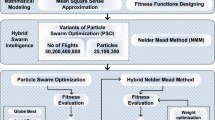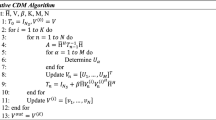Abstract
In this study, nature inspired computing (NIC) techniques are designed for estimation of channel co-efficients in multi-inputs multi-output (MIMO) networks. NIC methods based on recently introduced variants of swarm intelligence are exploited as optimization mechanism for MIMO channel co-efficients estimation. In MIMO systems there is m input matrix s multiplied with channel matrix H and there is some addition of noise ν and this whole is equivalent to output matrix r. In this research work, the goal is to achieve an optimized channel co-efficient matrix of different orders with the help of various NIC based optimization techniques. Such that MIMO networks give output exactly matching with the information sent by the transmitter. Comparative studies for the parameter estimation of MIMO networks against the true values of the parameters is evaluated by taking different cases, based on variations in the order of channel matrix and SNRs values. Performance analysis of the proposed NIC variants is conducted for single preferred run. NIC computing is done for equal number of antennas on transmitter and receiver end making a square channel matrix H. Four cases are taken in this research work for checking the trend of received signal for noisy channel like rayleigh fading channel. In each case channel estimation is developed by taking channel matrix of orders 2 × 2, 3 × 3, 4 × 4 and 8 × 8. In each case there are five sub cases which are without noise and for different values of SNR such as 70 db, 60 db, 50 db and 40 db.





Similar content being viewed by others
References
Knievel, C., & Hoeher, P. A. (2012). On particle swarm optimization for MIMO channel estimation. Journal of Electrical and Computer Engineering.
Telatar, E. (1999). Capacity of multi-antenna Gaussian channels. European Transactions on Telecommunications, 10(6), 585–596.
Foschini, G. J. (1996). Layered space-time architecture for wireless communication in fading environments when using multi-element antennas. Bell Labs Technic Journal, 41–59.
Winters, J. (1987). On the capacity of radio communication systems with diversity in a Rayleigh fading environment. IEEE Journal on Selected Areas in Communications, 5, 871–878.
Molisch, A. (2005). Wireless communications. New Jersey: Wiley-IEEE Press.
Gesbert, D., Shafi, M., Shiu, D., Smith, P., & Naguib, A. (2003). From theory to practice: An overview of MIMO space-time coded wireless systems. IEEE Journal on Selected Areas in Communications, 21(3), 281–302.
Dai, L., Zhou, S., Zhuang, H., & Yao, Y. (2002). Closed-loop MIMO architecture based on water filling. Electronics Letters, 38(25), 1718–1720.
Zheng, K., Huang, L., Wang, W., & Yang, G. (2005). TD-CDM-OFDM: Evolution of TD-SCDMA toward 4G. IEEE Communications Magazine, 43(1), 45–52.
Sampath, H., Talwar, S., Tellado, J., Erceg, V., & Paulraj, A. (2002). A fourth-generation MIMO-OFDM broadband wireless system: Design, performance, and field trial results. IEEE Communications Magazine, 40(9), 143–149.
Kennedy, J., & Eberhart, R. (1995). Particle swarm optimization. In Proceedings of the IEEE international conference on neural networks (pp. 1942–1948).
Gesbert, D., Shafi, M., Shiu, D., Smith, P., & Naguib, A. (2001). From theory to practice: An overview of swarm intelligence (p. 2001). Burlington: Morgan Kaufmann.
Goldberg, D. (1989). Genetic algorithms in search, optimization, and MachineLearning. Reading, MA: Addison-Wesley.
Alias, M. Y., Chen, S., & Hanzo, L. (2005). Multiple-antenna-aided OFDM employing genetic-algorithm-assisted minimum bit error ratemultiuser detection. IEEE Transactions on Vehicular Technology, 54(5), 1713–1721.
Civicioglu, P., & Besdok, E. (2016). A conceptual comparison of the Cuckoo-search, particle swarm optimization, differential evolution and artificial bee colony algorithms. Artificial Intelligence Review, 39(4), 315–346.
Yang, X. S., & Deb, S. (2009). Cuckoo search via levy flights World Congress on Nature and Biologically Inspired Computing (Vol. 4, pp. 210–214). Nabic-2009, Coimbatore, India.
Geem, Z. W., Kim, J. H., & Loganathan, G. V. (2001). A new heuristic optimization algorithm: harmony search. Simulation, 76, 60–68.
Almouti, S. M. (1998). A simple transmit diversity technique for wireless communication. IEEE Journal on Selected Areas in Communications, 16, 1451–1458.
Tao, S., Jiadong, X., & Kai, Z. (2007). Blind MIMO identification using particle swarm algorithm. In Proceedings of the international conference on wireless communications, networking and mobile computing (WiCom’07), Shanghai, China.
Dong, W., Li, J., & Lu, Z. (2008). Joint frequency offset and channel estimation for MIMO systems based on particle swarm optimization. In Proceedings of the IEEE 67th vehicular technology conference (VTC’08-Spring), Singapore.
Palally, H., Chen, S., Yao, W., & Hanzo, L. (2009). Particle swarm optimisation aided semi-blind joint maximum likelihood channel estimation and data detection for MIMO systems. In Proceedings of the IEEE/SP 15th workshop on statistical signal processing (SSP’09) (pp. 309–312).
Knievel, C., & Hoeher, P. A. (2012). On particle swarm optimization for MIMO channel estimation. London: Hindawi Publishing Corp.
Monika, & Mahendra Tyagi. (2017). Mimo channel estimation using fast converging evolutionary optimization algorithm. International Journal of Advance Research, Ideas and Innovations in Technology, 3(3).
Muhammad AsadUllah., et al. (2018). Blind channel and data estimation using fuzzy logic-empowered opposite learning-based mutant particle swarm Optimization. Computational Intelligence and Neuroscience.
Author information
Authors and Affiliations
Corresponding author
Additional information
Publisher's Note
Springer Nature remains neutral with regard to jurisdictional claims in published maps and institutional affiliations.
Rights and permissions
About this article
Cite this article
Ali, W., Li, Y. Design of Nature Inspired Computing Approach for Estimation of Channel Coefficients in MIMO Networks. Wireless Pers Commun 107, 2047–2069 (2019). https://doi.org/10.1007/s11277-019-06372-4
Published:
Issue Date:
DOI: https://doi.org/10.1007/s11277-019-06372-4




